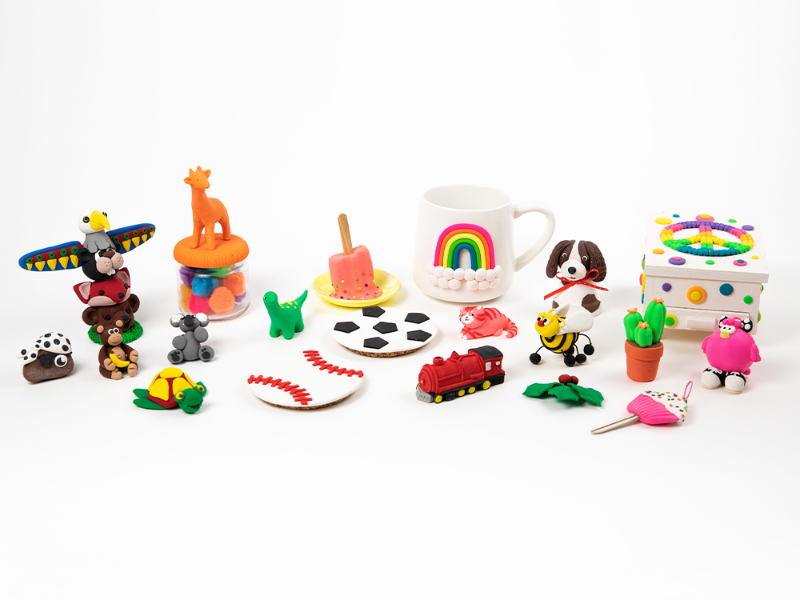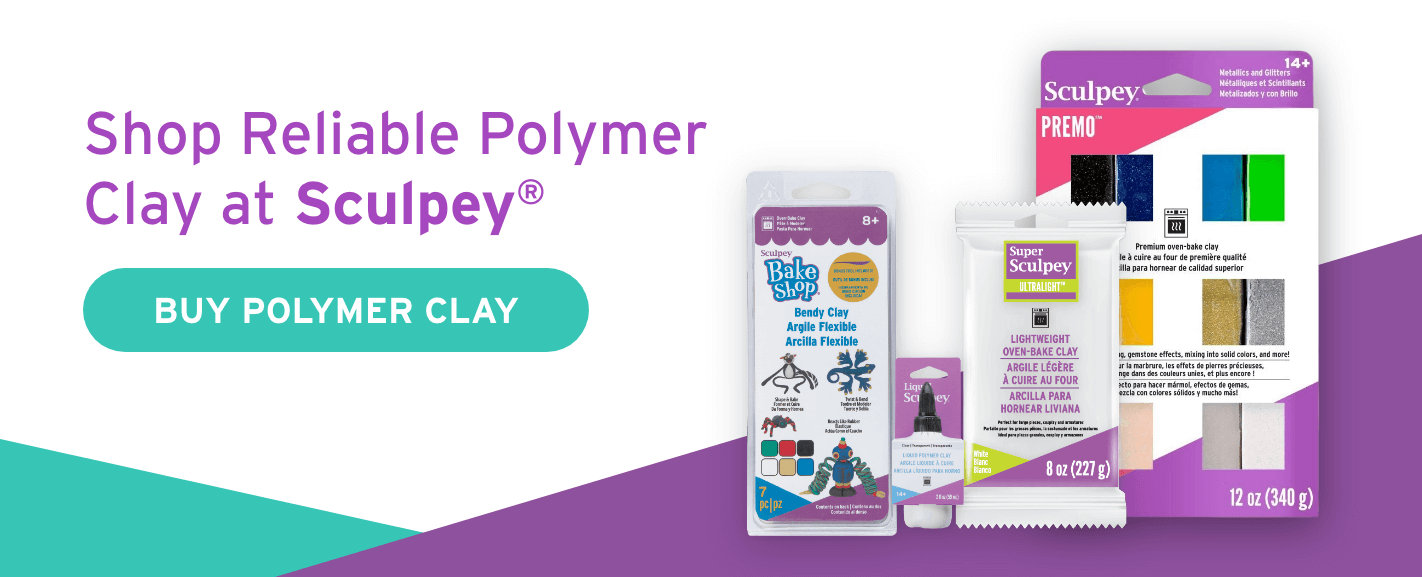Baking Polymer Clay
Baking Polymer Clay
Creating with clay is a unique, personal process that can produce so many possibilities, whether you’re making crafty, home décor like photo frames, mason jars and candlesticks, fun figurines, functional structures or crafts with kids. The best thing about working with polymer clay is how versatile and workable it is — and it’ll never dry out or crack, so it will stay soft and pliable until you bake it in your home oven. Whether you are wondering how to bake polymer clay earrings or are looking to bake a home decor piece, baking your clay creation properly will ensure a long lasting finished memory! Here are some tips and techniques ton baking polymer clay:
Creating with clay is a unique, personal process that can produce so many possibilities, whether you’re making crafty, home décor like photo frames, mason jars and candlesticks, fun figurines, functional structures or crafts with kids. The best thing about working with polymer clay is how versatile and workable it is — and it’ll never dry out or crack, so it will stay soft and pliable until you bake it in your home oven. Whether you are wondering how to bake polymer clay earrings or are looking to bake a home decor piece, baking your clay creation properly will ensure a long lasting finished memory! Here are some tips and techniques ton baking polymer clay:
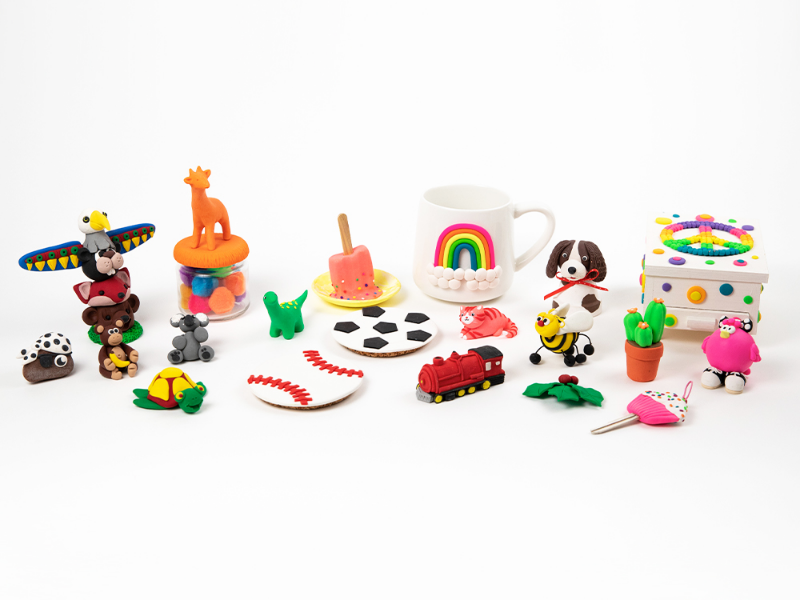
Table of Contents:
- How do you bake polymer clay?
- How long does it take to bake polymer clay?
- Do you have to bake polymer clay right away?
- Do you need to bake modeling clay?
- Additional Tips
Why Do You Need to Bake Polymer Clay?
When you order your Sculpey® polymer clay, you’ll get to play around with the soft texture. You can shape it, carve it and add all of the little details you want. However, polymer clay needs to cure to capture your hard work.
You cure polymer clay by baking it in the oven. Baking your piece enhances its durability and prevents it from getting misshapen or damaged.
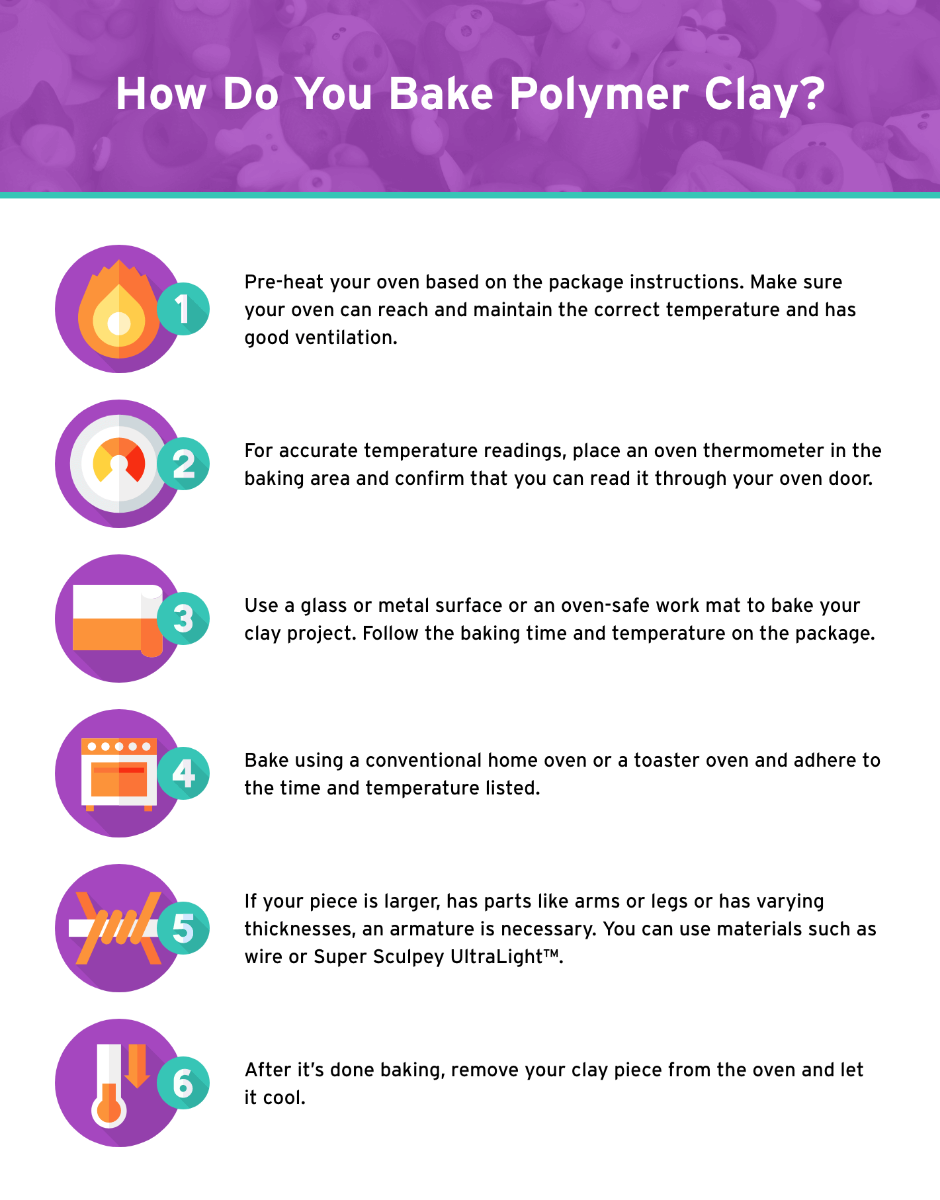
How Do You Bake Polymer Clay?
Polymer clay baking is a simple process that an adult should do. With some extra care and attention, your creation will be ready to share with the world in no time! Follow these clay baking instructions to ensure optimal results:
- Pre-heat your oven based on the package instructions. Make sure your oven can reach and maintain the correct temperature and has good ventilation.
- For accurate temperature readings, place an oven thermometer in the baking area and confirm that you can read it through your oven door.
- Use a glass or metal surface or an oven-safe work mat to bake your clay project. Follow the baking time and temperature on the package.
- Cover the clay with a tented piece of aluminum foil or cover it with an upside-down baking pan.
- Bake using a conventional home oven or a toaster oven and adhere to the time and temperature listed. In most cases, you can bake polymer clay at 275 degrees F for 15 to 30 minutes per ¼ inch of clay thickness. You should always check the package instructions for the most accurate information. Just make sure you don’t underbake the clay. This will lead to brittle pieces that break easily.
- If your piece is larger, has parts like arms or legs or has varying thicknesses, an armature is necessary. You can use materials such as wire or Super Sculpey UltraLight™.
- After it's done baking, remove your clay piece from the oven and let it cool.

How Long Does It Take to Bake Polymer Clay?
The most important factor when baking polymer clay is making sure your oven is at the right temperature. Some crafters find that their oven's recorded temperature is inaccurate, which can affect baking times. Test the accuracy of your oven by using a thermometer before baking.
You can also run a pre-baking test by following these steps:
- Shape a small ball of clay into a disc with a 1/2 inch (12 mm) diameter and 1/4 (6 mm) thickness.
- Bake the disc using your package’s recommended baking time and temperature.
- Check the color of your testing piece. If there are darkened areas, your oven is too hot.
- Lower your oven’s temperature by 10 degrees Fahrenheit (5 degrees Celsius) and repeat the test.
At Sculpey®, most of our clays have similar baking times where you can pre-heat the oven to 275 degrees F, or 130 degrees C, and bake for 15 to 30 minutes per ¼ inch of the clay thickness. Thicker pieces should be initially baked for 15 minutes, then an additional 5 minutes, another 5 minutes, etc. The clay needs at least 15 minutes to cure properly.
Each of the following requires 275 degrees F, or 130 degrees C, for 15 to 30 minutes per 1/4 inch of the clay thickness:

Other Baking Times
Other Sculpey® polymer clays that require different baking times are:

How Do You Know When Your Polymer Clay Project Is Done Baking?
Polymer clay stays soft while it's in the oven, and it will feel soft right when you take it out. The clay will harden as it cools. Instead of eyeballing the polymer clay to determine if it's done, you have to trust your estimated baking time.
If you leave your clay in the oven for too long, it can overheat and potentially crack and split. One method some crafters use to check their crafts is a "tester" piece of clay. Roll a bit of clay to the same thickness as your project, and bake it. If the tester comes out right, then you're ready to bake your project.
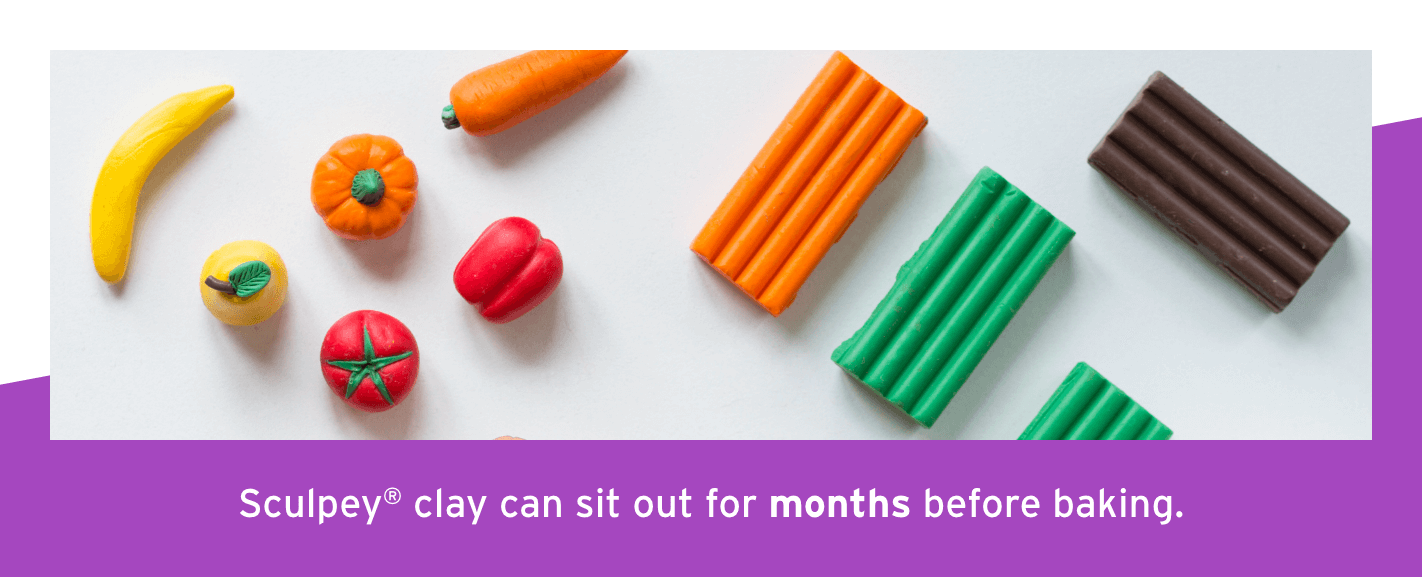
Do You Have to Bake Polymer Clay Right Away?
Sculpey® clay can sit out for months before baking. So, if you're someone who likes to take long breaks during projects, you'll enjoy the capabilities of polymer clay. Polymer clay is oil-based and maintains its moisture, which also keeps it malleable.
If you plan to set your polymer clay out for a long time, make sure you place it somewhere safe. Also, put cling wrap or another protective covering over your clay so it doesn't collect dust or other debris.
Do You Need to Bake Modeling Clay?
Sculpey® offers modeling clay products that are perfect for school projects, claymations and other freehand sculpting activities. What makes modeling clay unique is that you can enjoy crafting without having to bake your pieces. We have two types of modeling clay, each with its own distinct qualities:
Air-Dry™ Modeling Clay
Our Air-Dry™ Modeling Clay hardens at room temperature within 24 hours. It retains its shape after drying, allowing for plenty of creative and colorful marker scribbles afterward. Since there's no baking required, Air-Dry™ Modeling Clay is a suitable choice if you're working with large groups of young crafters.
While this modeling clay dries on its own, you can speed up the process by putting it in the oven. Use low temperatures — 200 degrees F or less — and leave it in for the appropriate amount of time. You should leave thinner pieces in for a minimum of 20 minutes. Thicker pieces can stay in for longer, but you should check them frequently.
Non-Dry™ Modeling Clay
Non-Dry™ Modeling Clay stands out from our other clay products due to its reusability. This modeling clay remains soft and pliable, meaning you can use it for many crafting projects to come. It shines in arts and crafts that require more flexibility, such as animation. As with Air-Dry™ Modeling Clay, no baking is necessary to enjoy our non-harden modeling clay.
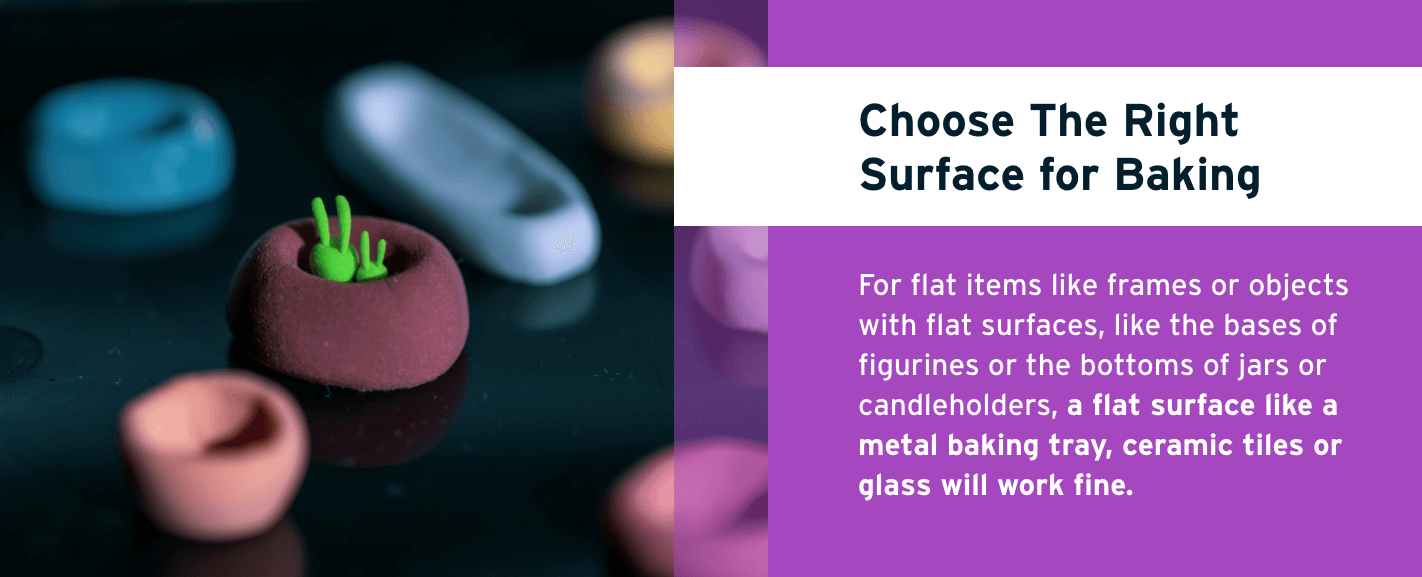
Additional Tips
Choose The Right Surface for Baking
You might be wondering what to bake polymer clay on — and it all depends on the piece. For flat items like frames or objects with flat surfaces, like the bases of figurines or the bottoms of jars or candleholders, a flat surface like a metal baking tray, ceramic tiles or glass will work fine. Make sure to use parchment paper or aluminum foil to cover ceramic tiles to prevent your items from developing an unwanted sheen and touching the ceramic surface you have created.
For objects that are round, or for shaped sculptures you want to perfectly preserve, you’ll need to choose another kind of surface. Polyester stuffing, shaped aluminum foil, cardboard holders, or our Sculpey® bead baking rack will help your clay items maintain their shapes while baking. While this modeling clay dries on its own, you can speed up the process by putting it in the oven. Use low temperatures — 200 degrees F or less — and leave it in for the appropriate amount of time. You should leave thinner pieces in for a minimum of 20 minutes. Thicker pieces can stay in for longer, but you should check them frequently.
Follow Package Instructions
When preheating your oven to bake your polymer clay, make sure you consult the directions on the package. They should give you an idea of what temperature to bake which clay and how long to leave it in the oven. For example, clays like Sculpey® Soufflé™, Sculpey® III and Premo! Sculpey® bake at 275 degrees F.
Carefully Consider Clay Thickness
Again, your package should give you a good estimate of how long baking your modeling clay will take. The time you’ll need to leave it in the oven depends on the thickness of the unbaked clay. Measure or approximate the depth of the thickest layer of your polymer creation. The directions on your package will tell you the baking time per a specific measurement, such as 1/4 inch.
For example, you’ll need to put our Sculpey® Soufflé™ product in the oven for an estimated 30 minutes for every 1/4 inch of thickness, while we recommend 15 minutes per 1/4 inch for Sculpey® III. Then, you must allow your polymer clay to cool properly to be cured completely and achieve the final level of hardness.
Shop Reliable Polymer Clay at Sculpey®
Are you a beginner crafter looking for a new hobby? Or, are you an experienced crafter looking for different types of polymer clay to try? Browse our wide selection of polymer clays online. And, for crafting inspiration, visit our how-to page!

